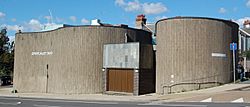Brighton and Hove National Spiritualist Church facts for kids
Quick facts for kids Brighton and Hove National Spiritualist Church |
|
|---|---|

The church from the southeast
|
|
| 50°49′20″N 0°07′53″W / 50.8223°N 0.1313°W | |
| Location | Edward Street, Carlton Hill, Brighton BN2 0JR |
| Country | England |
| Denomination | Spiritualist |
| History | |
| Former name(s) | Brighton National Spiritualist Church |
| Status | Church |
| Founded | 17 May 1902 |
| Events | 17 May 1965: present church registered 23 November 2019: amalgamated with Brighton and Hove Central Spiritualist Church |
| Architecture | |
| Functional status | Active |
| Heritage designation | Locally listed |
| Designated | 2015 |
| Architect(s) | Bev Pike (Overton & Partners) |
| Architectural type | Church |
| Style | Brutalist |
| Years built | 1964–65 |
| Completed | 1965 |
The Brighton and Hove National Spiritualist Church is a special place of worship in Brighton, England. It is for people who follow Spiritualism. This church is located in the Carlton Hill area of the city.
Until 2019, it was known as the Brighton National Spiritualist Church. After joining with another church in November 2019, it became one of the biggest Spiritualist churches in England.
The church started in 1902 and has been in different buildings over the years. The building it uses now was registered as a place of worship in 1965. It is known for its unique curved shape and Brutalist style, which means it uses strong, simple concrete designs. The Brighton and Hove City Council has recognized it as an important local heritage building.
Contents
Church History: A Journey Through Time
Brighton's first Spiritualist church officially began on May 17, 1902. A group of worshippers decided to hold weekly services in a room they had used before. They also chose their first leader at this meeting.
Finding a Permanent Home
For many years, the church rented different rooms. This changed in 1921 when they bought an old Baptist chapel. This chapel was in the Carlton Hill area, east of central Brighton. It was built in 1878 for a group called Strict Baptists.
The chapel was no longer used by Baptists after 1910. It was then used as a church hall for a nearby church. The Spiritualist group bought this building for £1,250. They named it the Brighton National Spiritualist Church. In January 1949, it was officially registered as a place of worship and for weddings.
Moving to a New Location
By the 1950s, the Carlton Hill area, including Edward Street, was undergoing big changes. Many old buildings were removed, and roads were made wider between 1961 and 1964. This was part of a plan to improve the main entry point to the town from the east.
Many properties, including the church on Mighell Street, were bought by the city. In March 1961, the church was able to get a new site further along Edward Street. Construction on the current church building started in 1964 and finished the next year.
On May 17, 1965, the new Brighton National Spiritualist Church was officially registered. It was licensed for weddings six weeks later. In July 2014, it was also registered to hold same-sex marriages.
Joining Forces: A Bigger Church
The church changed its name to Brighton and Hove National Spiritualist Church on November 23, 2019. This happened when it merged with another Spiritualist church in the city. The other church, Brighton and Hove Central Spiritualist Church, had closed its own building.
The Brighton and Hove Central Spiritualist Church was first mentioned in April 1925. It met at the Athenaeum Hall in North Street. This hall was built in 1890 for many uses, including recreation. Spiritualists used the hall until 1962, when it was bought for road widening.
The congregation then shared a building with another Spiritualist church until 1965. In July 1966, they registered part of a building on Norfolk Terrace as their new worship place. In 1978, they moved to a new building on Boundary Passage, which had been a house used for other purposes. This new church was dedicated in December 1978 and officially registered in July 1984. It held its last service before the merger on November 4, 2019.
Today, the Brighton and Hove National Spiritualist Church says it is "one of the largest Spiritualist churches in the country." It holds two Sunday services and other sessions almost every day. It is connected to the Spiritualists' National Union.
Church Design: A Modern Look
The company Overton & Partners designed the new church in 1964. The main architect for the project was Bev Pike.
The northern side of Edward Street was built in the 1960s and 1970s. It has many "prominent buildings," including the church, which has an "unusual figure-of-eight design." The building has two parts connected by an entrance area with a flat roof.
The longer left side of the church is shaped like a kidney on the outside, but it is oblong inside. The smaller, round worship area on the right is lit by a round window in the roof. The left worship space also gets light from square openings in the roof. The outside of the building has no windows. It is made of concrete blocks placed vertically, looking like a brick pattern.
The curved walls make the building look softer, even though they are solid and have no openings. The smooth, angled entrance building also creates a nice contrast. The inside of the worship area is lined with brick.
In 2015, Brighton and Hove City Council added the church to its Local List of Heritage Assets. They called it a "good example of a modern design of place of worship." They also said it "contributes positively to the streetscene" and that its outside has "largely unaltered" over time.
See also

